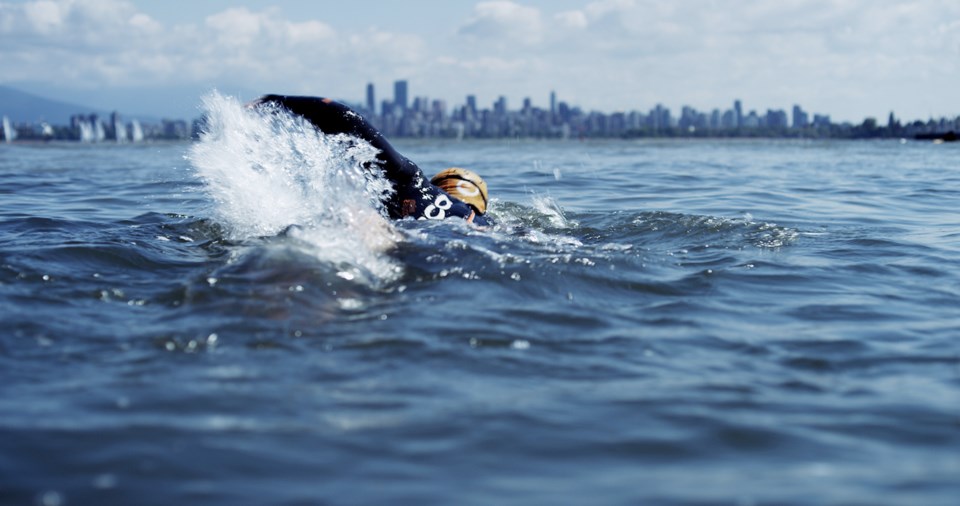Is it the obsessive spirit of a relentless type-A personality that drives a triathlete to excel at three distinct disciplines? Or do you just have to be a little unhinged to win?
Filmmaker and writer Theo Devaney asks these questions in the 15-minute short, Run, shot on location in Â鶹´«Ă˝Ół»last November and this month.
“Triathletes have made a pact with themselves that they will suffer more than anyone else to become the best in a tri-discipline sport,” said Devaney, who also acts in the lead role of Tristan Selina, an Olympian and elite racer competing at the highest echelons of the sport.
“They are some really, really extraordinarily driven people. Triathletes are obsessed about their sport,” said the filmmaker who turned this fanaticism to the extreme in order to look at the mental vulnerability of a professional athlete.Â
The short sports flick plumbs greater psychological depths when an unexpected turn in Tristan’s life triggers a past trauma, interrupting his isolation while he’s singularly focused on a career-defining race.
“What makes this triathlete who he is? What is it,” asked Devaney. “Suffering is not an obstacle for him anymore. It’s almost a necessity. He knows he’s doing it right because it hurts.”
Shot on location at Jericho Beach Park, under the Lions Gate Bridge on the seawall in Stanley Park and at a high-performance training centre in Burnaby, Run purposefully casts the city as itself. Produced by Scopitone Films, Run’s cinematographer Stirling Bancroft captured the effortless natural beauty of the very mountains and shoreline that make Â鶹´«Ă˝Ół»a premier training ground for the world’s triathletes.
Run was funded privately and through a Kickstarter campaign that raised $23,500. Delaney and director Elad Tzadok will submit the short for consideration at film festivals, including TIFF. A Â鶹´«Ă˝Ół»screening is tentatively planned for this summer.Â
The filmmakers believe Run is the first fictional film with triathlon driving the narrative arc. In 2013, Kelly Brothers Production made A Second Chance: The Janelle Morrison Story, of the Penticton Ironman bronze medallist after a horrific car accident all but killed her. Her phenomenal physical condition may have saved her and certainly influenced her rapid recovery, one doctor says in the film.
The setting of Devaney’s film is an integral part of its authenticity. The sport’s international governing body, the ITU, operates one of three international offices from North Â鶹´«Ă˝Ół»where it was founded 25 years ago, and Triathlon B.C. became one of the first organization anywhere to focus solely on the sport when it launched in 1989. Devaney consulted with both to make Run.
“A lot of people come to Â鶹´«Ă˝Ół»to train,” said Devaney, an Englishman known for his acting role in the television series Supernatural, which is shot at dozens of locations throughout B.C., and keeps the Londoner in his adopted home on the Pacific Coast.
“Kitsilano is just full — full of runners, swimmers, bikers, people who do triathlon and professional athletes,” he said.Â
To add further credibility to their portrayal of everything in a triathlete’s life from lingo to psychological profile, the filmmakers consulted with 2015 Ironman Melbourne champion Jeff Symonds and 2006 Ironman Canada winner Jasper Blake who lives in Victoria and, with only one exception from 2000 to 2011, finished in the top five of every Ironman he entered.
The ITU supplied race-day signage genuinely used for triathlons. Lululemon — the Kits trademark whose founder Chip Wilson is an amateur triathlete — makes a cameo appearance.
And Symonds, who grew up in Penticton where the Canadian Ironman championship was held for 30 years, not only acts in the film but also lent the filmmakers his wetsuit, bicycle and shoes to ensure the protagonist looked the part.
“We met up and I gave them my take on what pro triathlon is actually like so the tri community would view it and say, this is real,” said Symonds.
“They gave me a bit part,” he added, laughing and proud of his role. In the film, Symonds’s character calls to Tristan on Kitsilano Beach — which is in the same neighbourhood the Ironman champ now calls home.
To validate a major theme of the film, Symonds said triathletes do tend toward the obsessive: “Maybe all sport is this way.”
“You really do need to be a student of your craft and be obsessed and put everything into it,” he said. “Where triathlon might be different is that you’re talking about three sports, so there is so much more to wrap your head around and understand. It’s to your advantage to be that much more obsessed to really master the craft.”
An Olympic triathlon includes a 1,500-metre swim in open water, a 40-kilometre bike ride and 10-km run, each following the other with rapid transitions in between. The Ironman stretches the limit of human endurance by covering AA kilometres with a 3,860-metre swim, 180-km bike ride and a 42.2-kilometre run, the same distance as a marathon. In March in Australia, Symonds in eight hours, four minutes and 29 seconds. Â
The story Devaney tells isn’t based on the life of any one triathlete, but as he researched the sport and wrote the script, he found a pattern among the most elite racers, including a British Olympian whose split for his 10-kilometre run was not far off the gold-medal winning time in the 10,000 metre track and field event.
“His mentality is such that he’s understood to have no fear,” said Devaney. “He's doing it with his heart and he’s not listening to his body. He’s, in a sense, instructing this body and is determined to move through his limits, pushing himself through his threshold and move as fast as he possibly can.”
But being the fastest in one sport just isn’t enough. A triathlete pushes the human limit, in the swim, bike and run.



